Yudong Li
FaceBench: A Multi-View Multi-Level Facial Attribute VQA Dataset for Benchmarking Face Perception MLLMs
Mar 27, 2025Abstract:Multimodal large language models (MLLMs) have demonstrated remarkable capabilities in various tasks. However, effectively evaluating these MLLMs on face perception remains largely unexplored. To address this gap, we introduce FaceBench, a dataset featuring hierarchical multi-view and multi-level attributes specifically designed to assess the comprehensive face perception abilities of MLLMs. Initially, we construct a hierarchical facial attribute structure, which encompasses five views with up to three levels of attributes, totaling over 210 attributes and 700 attribute values. Based on the structure, the proposed FaceBench consists of 49,919 visual question-answering (VQA) pairs for evaluation and 23,841 pairs for fine-tuning. Moreover, we further develop a robust face perception MLLM baseline, Face-LLaVA, by training with our proposed face VQA data. Extensive experiments on various mainstream MLLMs and Face-LLaVA are conducted to test their face perception ability, with results also compared against human performance. The results reveal that, the existing MLLMs are far from satisfactory in understanding the fine-grained facial attributes, while our Face-LLaVA significantly outperforms existing open-source models with a small amount of training data and is comparable to commercial ones like GPT-4o and Gemini. The dataset will be released at https://github.com/CVI-SZU/FaceBench.
GTG: Generalizable Trajectory Generation Model for Urban Mobility
Feb 03, 2025



Abstract:Trajectory data mining is crucial for smart city management. However, collecting large-scale trajectory datasets is challenging due to factors such as commercial conflicts and privacy regulations. Therefore, we urgently need trajectory generation techniques to address this issue. Existing trajectory generation methods rely on the global road network structure of cities. When the road network structure changes, these methods are often not transferable to other cities. In fact, there exist invariant mobility patterns between different cities: 1) People prefer paths with the minimal travel cost; 2) The travel cost of roads has an invariant relationship with the topological features of the road network. Based on the above insight, this paper proposes a Generalizable Trajectory Generation model (GTG). The model consists of three parts: 1) Extracting city-invariant road representation based on Space Syntax method; 2) Cross-city travel cost prediction through disentangled adversarial training; 3) Travel preference learning by shortest path search and preference update. By learning invariant movement patterns, the model is capable of generating trajectories in new cities. Experiments on three datasets demonstrates that our model significantly outperforms existing models in terms of generalization ability.
Dynamic data sampler for cross-language transfer learning in large language models
May 17, 2024Abstract:Large Language Models (LLMs) have gained significant attention in the field of natural language processing (NLP) due to their wide range of applications. However, training LLMs for languages other than English poses significant challenges, due to the difficulty in acquiring large-scale corpus and the requisite computing resources. In this paper, we propose ChatFlow, a cross-language transfer-based LLM, to address these challenges and train large Chinese language models in a cost-effective manner. We employ a mix of Chinese, English, and parallel corpus to continuously train the LLaMA2 model, aiming to align cross-language representations and facilitate the knowledge transfer specifically to the Chinese language model. In addition, we use a dynamic data sampler to progressively transition the model from unsupervised pre-training to supervised fine-tuning. Experimental results demonstrate that our approach accelerates model convergence and achieves superior performance. We evaluate ChatFlow on popular Chinese and English benchmarks, the results indicate that it outperforms other Chinese models post-trained on LLaMA-2-7B.
Rethinking Residual Connection in Training Large-Scale Spiking Neural Networks
Nov 09, 2023Abstract:Spiking Neural Network (SNN) is known as the most famous brain-inspired model, but the non-differentiable spiking mechanism makes it hard to train large-scale SNNs. To facilitate the training of large-scale SNNs, many training methods are borrowed from Artificial Neural Networks (ANNs), among which deep residual learning is the most commonly used. But the unique features of SNNs make prior intuition built upon ANNs not available for SNNs. Although there are a few studies that have made some pioneer attempts on the topology of Spiking ResNet, the advantages of different connections remain unclear. To tackle this issue, we analyze the merits and limitations of various residual connections and empirically demonstrate our ideas with extensive experiments. Then, based on our observations, we abstract the best-performing connections into densely additive (DA) connection, extend such a concept to other topologies, and propose four architectures for training large-scale SNNs, termed DANet, which brings up to 13.24% accuracy gain on ImageNet. Besides, in order to present a detailed methodology for designing the topology of large-scale SNNs, we further conduct in-depth discussions on their applicable scenarios in terms of their performance on various scales of datasets and demonstrate their advantages over prior architectures. At a low training expense, our best-performing ResNet-50/101/152 obtain 73.71%/76.13%/77.22% top-1 accuracy on ImageNet with 4 time steps. We believe that this work shall give more insights for future works to design the topology of their networks and promote the development of large-scale SNNs. The code will be publicly available.
VisorGPT: Learning Visual Prior via Generative Pre-Training
May 24, 2023Abstract:Various stuff and things in visual data possess specific traits, which can be learned by deep neural networks and are implicitly represented as the visual prior, \emph{e.g.,} object location and shape, in the model. Such prior potentially impacts many vision tasks. For example, in conditional image synthesis, spatial conditions failing to adhere to the prior can result in visually inaccurate synthetic results. This work aims to explicitly learn the visual prior and enable the customization of sampling. Inspired by advances in language modeling, we propose to learn Visual prior via Generative Pre-Training, dubbed VisorGPT. By discretizing visual locations of objects, \emph{e.g.,} bounding boxes, human pose, and instance masks, into sequences, \our~can model visual prior through likelihood maximization. Besides, prompt engineering is investigated to unify various visual locations and enable customized sampling of sequential outputs from the learned prior. Experimental results demonstrate that \our~can effectively model the visual prior, which can be employed for many vision tasks, such as customizing accurate human pose for conditional image synthesis models like ControlNet. Code will be released at https://github.com/Sierkinhane/VisorGPT.
TencentPretrain: A Scalable and Flexible Toolkit for Pre-training Models of Different Modalities
Dec 13, 2022
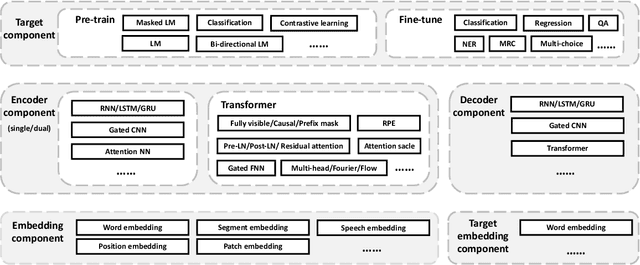
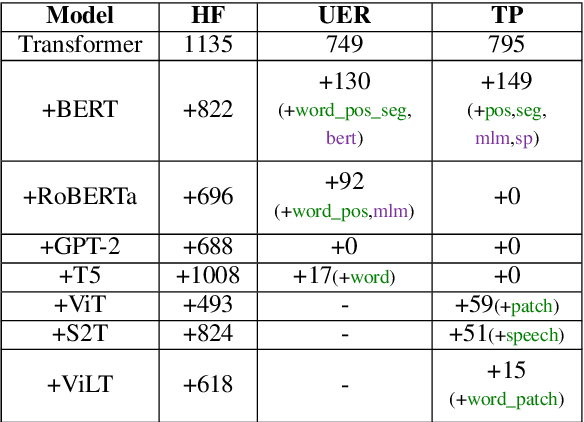

Abstract:Recently, the success of pre-training in text domain has been fully extended to vision, audio, and cross-modal scenarios. The proposed pre-training models of different modalities are showing a rising trend of homogeneity in their model structures, which brings the opportunity to implement different pre-training models within a uniform framework. In this paper, we present TencentPretrain, a toolkit supporting pre-training models of different modalities. The core feature of TencentPretrain is the modular design. The toolkit uniformly divides pre-training models into 5 components: embedding, encoder, target embedding, decoder, and target. As almost all of common modules are provided in each component, users can choose the desired modules from different components to build a complete pre-training model. The modular design enables users to efficiently reproduce existing pre-training models or build brand-new one. We test the toolkit on text, vision, and audio benchmarks and show that it can match the performance of the original implementations.
Spikeformer: A Novel Architecture for Training High-Performance Low-Latency Spiking Neural Network
Nov 19, 2022



Abstract:Spiking neural networks (SNNs) have made great progress on both performance and efficiency over the last few years,but their unique working pattern makes it hard to train a high-performance low-latency SNN.Thus the development of SNNs still lags behind traditional artificial neural networks (ANNs).To compensate this gap,many extraordinary works have been proposed.Nevertheless,these works are mainly based on the same kind of network structure (i.e.CNN) and their performance is worse than their ANN counterparts,which limits the applications of SNNs.To this end,we propose a novel Transformer-based SNN,termed "Spikeformer",which outperforms its ANN counterpart on both static dataset and neuromorphic dataset and may be an alternative architecture to CNN for training high-performance SNNs.First,to deal with the problem of "data hungry" and the unstable training period exhibited in the vanilla model,we design the Convolutional Tokenizer (CT) module,which improves the accuracy of the original model on DVS-Gesture by more than 16%.Besides,in order to better incorporate the attention mechanism inside Transformer and the spatio-temporal information inherent to SNN,we adopt spatio-temporal attention (STA) instead of spatial-wise or temporal-wise attention.With our proposed method,we achieve competitive or state-of-the-art (SOTA) SNN performance on DVS-CIFAR10,DVS-Gesture,and ImageNet datasets with the least simulation time steps (i.e.low latency).Remarkably,our Spikeformer outperforms other SNNs on ImageNet by a large margin (i.e.more than 5%) and even outperforms its ANN counterpart by 3.1% and 2.2% on DVS-Gesture and ImageNet respectively,indicating that Spikeformer is a promising architecture for training large-scale SNNs and may be more suitable for SNNs compared to CNN.We believe that this work shall keep the development of SNNs in step with ANNs as much as possible.Code will be available.
Tenrec: A Large-scale Multipurpose Benchmark Dataset for Recommender Systems
Oct 20, 2022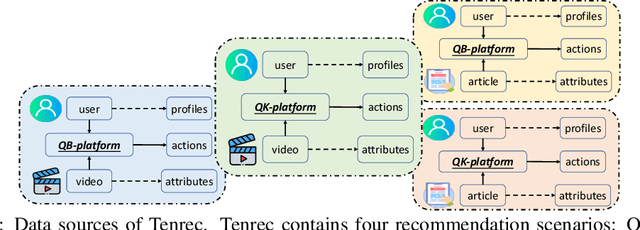
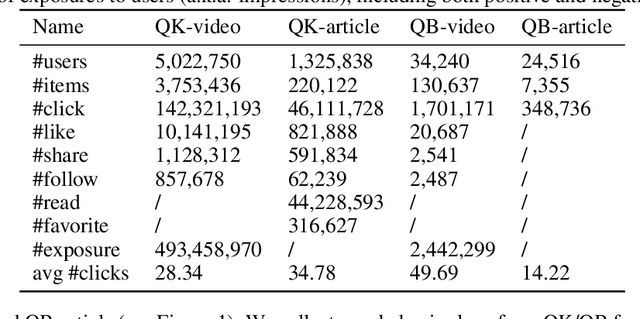


Abstract:Existing benchmark datasets for recommender systems (RS) either are created at a small scale or involve very limited forms of user feedback. RS models evaluated on such datasets often lack practical values for large-scale real-world applications. In this paper, we describe Tenrec, a novel and publicly available data collection for RS that records various user feedback from four different recommendation scenarios. To be specific, Tenrec has the following five characteristics: (1) it is large-scale, containing around 5 million users and 140 million interactions; (2) it has not only positive user feedback, but also true negative feedback (vs. one-class recommendation); (3) it contains overlapped users and items across four different scenarios; (4) it contains various types of user positive feedback, in forms of clicks, likes, shares, and follows, etc; (5) it contains additional features beyond the user IDs and item IDs. We verify Tenrec on ten diverse recommendation tasks by running several classical baseline models per task. Tenrec has the potential to become a useful benchmark dataset for a majority of popular recommendation tasks.
CSL: A Large-scale Chinese Scientific Literature Dataset
Sep 12, 2022



Abstract:Scientific literature serves as a high-quality corpus, supporting a lot of Natural Language Processing (NLP) research. However, existing datasets are centered around the English language, which restricts the development of Chinese scientific NLP. In this work, we present CSL, a large-scale Chinese Scientific Literature dataset, which contains the titles, abstracts, keywords and academic fields of 396k papers. To our knowledge, CSL is the first scientific document dataset in Chinese. The CSL can serve as a Chinese corpus. Also, this semi-structured data is a natural annotation that can constitute many supervised NLP tasks. Based on CSL, we present a benchmark to evaluate the performance of models across scientific domain tasks, i.e., summarization, keyword generation and text classification. We analyze the behavior of existing text-to-text models on the evaluation tasks and reveal the challenges for Chinese scientific NLP tasks, which provides a valuable reference for future research. Data and code are available at https://github.com/ydli-ai/CSL
RODNet: A Real-Time Radar Object Detection Network Cross-Supervised by Camera-Radar Fused Object 3D Localization
Feb 09, 2021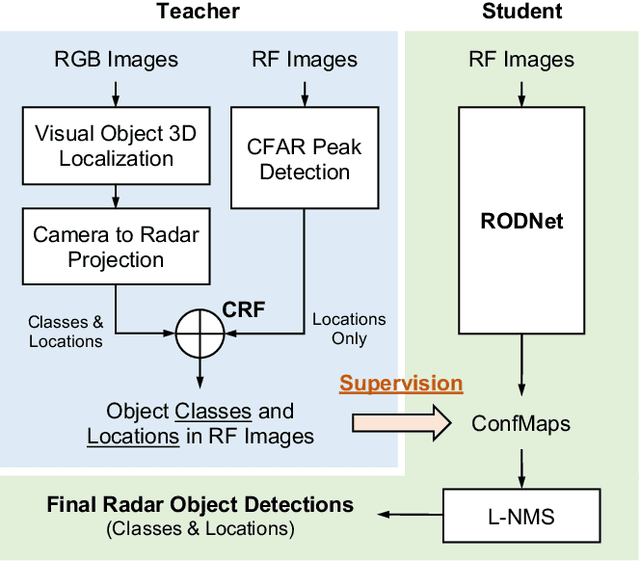
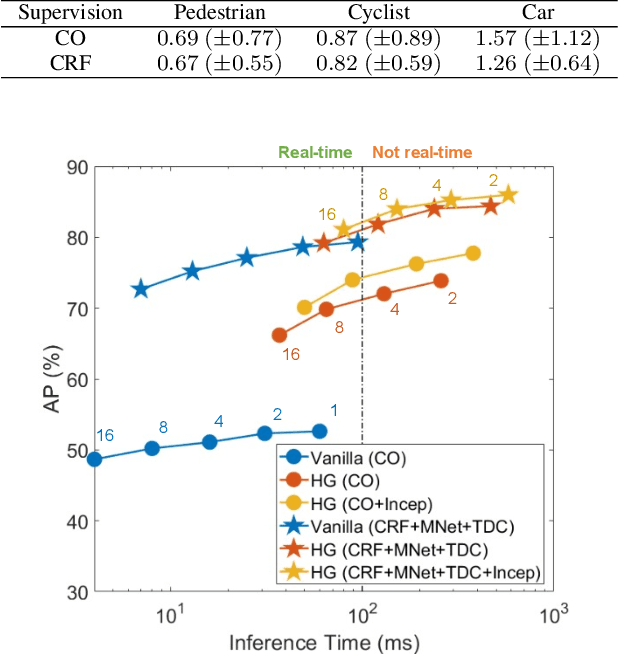
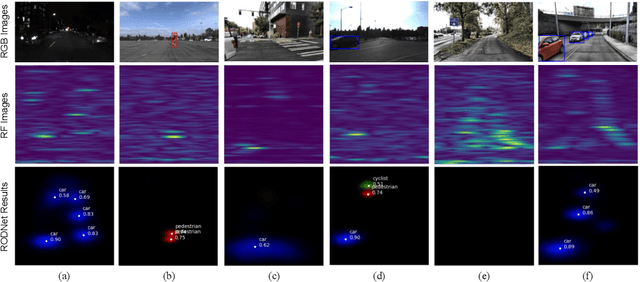
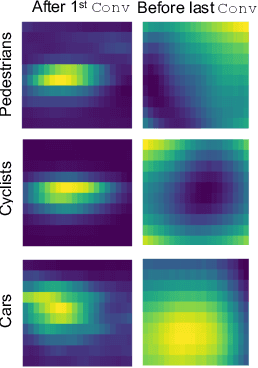
Abstract:Various autonomous or assisted driving strategies have been facilitated through the accurate and reliable perception of the environment around a vehicle. Among the commonly used sensors, radar has usually been considered as a robust and cost-effective solution even in adverse driving scenarios, e.g., weak/strong lighting or bad weather. Instead of considering to fuse the unreliable information from all available sensors, perception from pure radar data becomes a valuable alternative that is worth exploring. In this paper, we propose a deep radar object detection network, named RODNet, which is cross-supervised by a camera-radar fused algorithm without laborious annotation efforts, to effectively detect objects from the radio frequency (RF) images in real-time. First, the raw signals captured by millimeter-wave radars are transformed to RF images in range-azimuth coordinates. Second, our proposed RODNet takes a sequence of RF images as the input to predict the likelihood of objects in the radar field of view (FoV). Two customized modules are also added to handle multi-chirp information and object relative motion. Instead of using human-labeled ground truth for training, the proposed RODNet is cross-supervised by a novel 3D localization of detected objects using a camera-radar fusion (CRF) strategy in the training stage. Finally, we propose a method to evaluate the object detection performance of the RODNet. Due to no existing public dataset available for our task, we create a new dataset, named CRUW, which contains synchronized RGB and RF image sequences in various driving scenarios. With intensive experiments, our proposed cross-supervised RODNet achieves 86% average precision and 88% average recall of object detection performance, which shows the robustness to noisy scenarios in various driving conditions.
 Add to Chrome
Add to Chrome Add to Firefox
Add to Firefox Add to Edge
Add to Edge